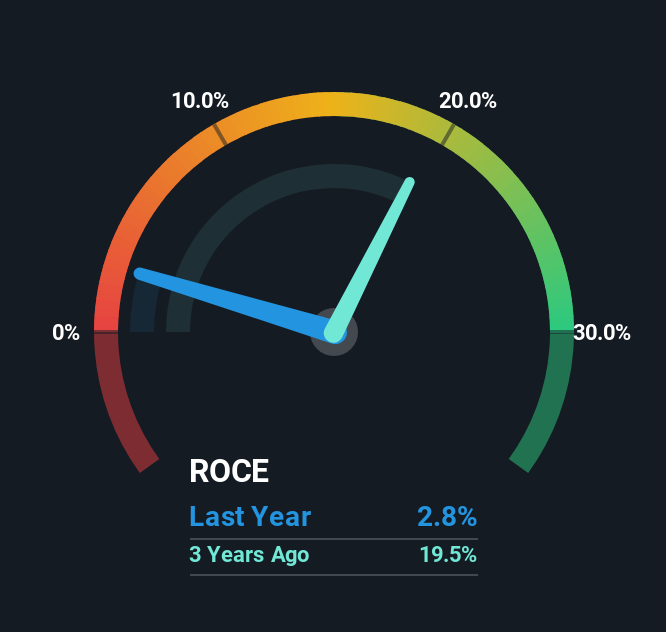These Return Metrics Don't Make QleanAir (STO:QAIR) Look Too Strong
Ignoring the stock price of a company, what are the underlying trends that tell us a business is past the growth phase? Typically, we'll see the trend of both return on capital employed (ROCE) declining and this usually coincides with a decreasing amount of capital employed. Basically the company is earning less on its investments and it is also reducing its total assets. Having said that, after a brief look, QleanAir (STO:QAIR) we aren't filled with optimism, but let's investigate further.
Return On Capital Employed (ROCE): What Is It?
For those that aren't sure what ROCE is, it measures the amount of pre-tax profits a company can generate from the capital employed in its business. To calculate this metric for QleanAir, this is the formula:
Return on Capital Employed = Earnings Before Interest and Tax (EBIT) ÷ (Total Assets - Current Liabilities)
0.028 = kr8.8m ÷ (kr598m - kr285m) (Based on the trailing twelve months to March 2025).
Therefore, QleanAir has an ROCE of 2.8%. Ultimately, that's a low return and it under-performs the Commercial Services industry average of 11%.
View our latest analysis for QleanAir

In the above chart we have measured QleanAir's prior ROCE against its prior performance, but the future is arguably more important. If you'd like to see what analysts are forecasting going forward, you should check out our free analyst report for QleanAir .
What The Trend Of ROCE Can Tell Us
In terms of QleanAir's historical ROCE movements, the trend doesn't inspire confidence. Unfortunately the returns on capital have diminished from the 17% that they were earning five years ago. Meanwhile, capital employed in the business has stayed roughly the flat over the period. Companies that exhibit these attributes tend to not be shrinking, but they can be mature and facing pressure on their margins from competition. If these trends continue, we wouldn't expect QleanAir to turn into a multi-bagger.
On a separate but related note, it's important to know that QleanAir has a current liabilities to total assets ratio of 48%, which we'd consider pretty high. This effectively means that suppliers (or short-term creditors) are funding a large portion of the business, so just be aware that this can introduce some elements of risk. While it's not necessarily a bad thing, it can be beneficial if this ratio is lower.
The Bottom Line On QleanAir's ROCE
In summary, it's unfortunate that QleanAir is generating lower returns from the same amount of capital. Investors haven't taken kindly to these developments, since the stock has declined 45% from where it was five years ago. That being the case, unless the underlying trends revert to a more positive trajectory, we'd consider looking elsewhere.
If you want to know some of the risks facing QleanAir we've found 2 warning signs (1 is concerning!) that you should be aware of before investing here.
While QleanAir isn't earning the highest return, check out this free list of companies that are earning high returns on equity with solid balance sheets.
Valuation is complex, but we're here to simplify it.
Discover if QleanAir might be undervalued or overvalued with our detailed analysis, featuring fair value estimates, potential risks, dividends, insider trades, and its financial condition.
Access Free AnalysisHave feedback on this article? Concerned about the content? Get in touch with us directly. Alternatively, email editorial-team (at) simplywallst.com.
This article by Simply Wall St is general in nature. We provide commentary based on historical data and analyst forecasts only using an unbiased methodology and our articles are not intended to be financial advice. It does not constitute a recommendation to buy or sell any stock, and does not take account of your objectives, or your financial situation. We aim to bring you long-term focused analysis driven by fundamental data. Note that our analysis may not factor in the latest price-sensitive company announcements or qualitative material. Simply Wall St has no position in any stocks mentioned.
About OM:QAIR
QleanAir
Provides air cleaning solutions for indoor environments in Sweden and internationally.
High growth potential and fair value.
Market Insights
Community Narratives





